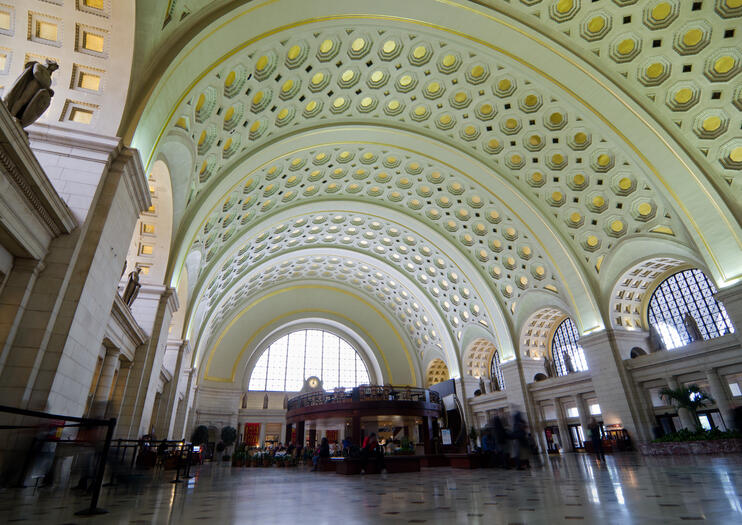

In 1988, the city filed suit against Trizec for the failure to develop the station the case was settled in 1994. By this time, the station was essentially closed. In 1985, Amtrak moved all passenger operations to a smaller "Amshack" facility adjacent to the old station. Between 19, Trizec constructed two office buildings on surrounding property, but did not redevelop the station. Included in the deal was an agreement that Trizec would redevelop the station. To facilitate this, in 1974, they made a development deal with Trizec Corporation, a Canadian redevelopment firm. The city government of Kansas City wished to preserve and redevelop the building. By 1973, only 32,842 passengers passed through the facility, all passenger train service was now run by Amtrak, and the building was beginning to deteriorate. As train travel declined beginning in the 1950s, the city had less and less need for a large train station. In 1945, annual passenger traffic peaked at 678,363. The Kansas City Massacre highlighted the lawlessness of Kansas City under the Pendergast Machine and resulted in the arming of all FBI agents.
#Union station free#
Union Station made headlines on June 17, 1933, as four lawmen were gunned down by gang members attempting to free captured fugitive Frank Nash. The scale of the building reflected this status. Due to its central location, Kansas City was a hub for both passenger and freight rail traffic. The building encompassed 850,000 square feet (79,000 m 2), the ceiling in the Grand Hall is 95 feet (29 m) high, there are three chandeliers weighing 3,500 pounds (1600 kg) each, and the Grand Hall clock has a six-foot (1.8-m) diameter face.

The Beaux-Arts station opened on October 30, 1914, as the third-largest train station in the country. The design was a main hall for ticketing, and a perpendicular hall extending out over the tracks for passenger waiting. The architect chosen to design the Union Station building was Jarvis Hunt, a proponent of the City Beautiful movement. It was south of the central business district, above and away from the floodplain. The new location was chosen to be a valley at 25th Street and Grand Avenue used by the Kansas City Belt Railway. Chicago, Rock Island and Pacific Railroad.Chicago, Burlington and Quincy Railroad.The decision to build a new station was spearheaded by the Kansas City Terminal Railway, a switching and terminal railroad that was a joint operation of the following railroad lines: In 1903, the lack of room for expansion and a major flood led the city and the railroads to decide a new station was required. By the start of the 20th century, over 180 trains were passing daily through the station, serving a city whose population had tripled during its first-quarter century of operation.
#Union station windows#
The lead architect was Asa Beebe Cross who "adorned the exterior of the building with intricate towers of varying heights, arched windows framed in stone and rows of dormers projecting from the steeply pitched mansard roof" it had a clock tower above the main entrance that was 125 feet (38 m) in height. The new depot was a hybrid of the Second Empire style and Gothic Revival. Nicknamed the "Jackson County Insane Asylum" by those who thought it was too large, it was the second union station in the country, after the one in Indianapolis. Joseph Railroad in present-day West Bottoms. On April 8, 1878, Union Depot opened on a narrow triangle of land in Kansas City between Union Avenue and the railroad tracks of the Hannibal and St. History Fountains in front of Union Station, 2012 Grand Hall of Union Station, 2011 Grand Plaza or North Waiting Room (also now known as Sprint Festival Plaza) of Union Station, 2011 Union Depot Since 2016, it is also a stop on the KC Streetcar. The refurbished station boasts theaters, ongoing museum exhibits, and attractions such as the Science City at Union Station, the Irish Museum and Cultural Center, and the Todd Bolender Center for Dance and Creativity. In 2002, Union Station saw its return as a train station when Amtrak began providing public transportation services and has since become Missouri's second-busiest train station.
#Union station series#
By 1999, the station reopened as a series of museums and other public attractions. In 1996, a public–private partnership undertook Union Station's $250 million restoration, funded in part by a sales tax levied in both Kansas and Missouri counties in the Kansas City metropolitan area. Union Station served a peak annual traffic of more than 670,000 passengers in 1945 at the end of World War II, quickly declined in the 1950s, and was closed in 1985. It replaced a small Union Depot from 1878. Kansas City Union Station ( station code: KCY) is a union station opened in 1914, serving Kansas City, Missouri, and the surrounding metropolitan area.


 0 kommentar(er)
0 kommentar(er)
